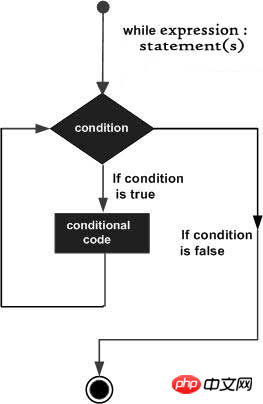
As a programming language, Python naturally has its own loop statement. Among them, the more common ones are the Python while loop statement and the for loop statement. (Students with programming background should note that in the Python while loop statement, there is no do...while loop statement in the format)
Python as the background Language, based on other languages, takes the essence and discards the dross: from the perspective of loop statements alone, what it uses is irreplaceable in other languages, and on this basis, combined with the actual situation in the background , the behavior of "complicating logic for the sake of simplicity" in some languages has been abandoned.
When I first learned programming, my teacher asked me a question: "How are your math and English?" At first I didn't know why I suddenly asked this question, But as my study gradually deepened, I gradually understood the teacher’s original intention: For those who have a mathematical foundation and want to learn the logic language with the widest coverage of programming, it will be better than others higher efficiency. Of course, the so-called "mathematical foundation" only requires mastering junior high school mathematics.
As for English, naturally, we all know that the Python language was first invented and released in the United States. Therefore, when a computer is personified, the computer language expressed in English is the "native language" of the personified computer. .
Next, we will start to explain the Python while loop statement:

(Figure 1.1)
Figure 1.1 expresses the loop process of the entire while loop statement, also called loop logic
The condition is often the condition we give to while A condition set by the loop is always the true (true) condition. The while loop statement will start looping only when the condition is true. When the condition is false (not true), the while statement ends. cycle.
The following is an example loop statement when the while statement condition is true.
eg:
python code:
#!/usr/bin/ env python
# -*- coding: UTF-8 -*-
count = 0
while (count < 9):
print 'The count is:', count
count = count + 1
print "Good bye!"Run it and the results are as follows:
The count is: 0 The count is: 1 The count is: 2 The count is: 3 The count is: 4 The count is: 5 The count is: 6 The count is: 7 The count is: 8 Good bye!
Synchronous analysis:
#!/usr/bin/env python
and general #! /usr/bin/ python is different. I added env in front of python. env is to prevent users from not inserting / The python file is under the /usr/bin file, and the editor can also find the python file smoothly.
# -*- coding: UTF-8 -*-
In order to ensure that the Chinese edited in the background can be displayed normally
count = 0
Assign a value to the variable count, the value is 0
while(count < 9):
The while loop starts, and the loop true is set to: when count is less than 9
print'The count is:' , count
Use print to output a string variable on python, for "the count is the variable output we set "
count = count +1
whlie's#trueAfter meeting the conditions, the loop will continue, which is count 1, and count After adding one, the value is assigned to count
print"Good bye!"
again. The meaning of this line of code is that when count is greater than 9, that is, another string output after count no longer meets the conditions of true, and another output
The above is to python while The explanation and synchronous analysis of loop statement , I hope it will be helpful to everyone when you encounter related problems. I also hope that everyone can understand the usage of Python while loop statement through this article.
Extracurricular extension:
Python introductory loop: for loop and else usage, with detailed examples included
The above is the detailed content of Python while loop statement explanation and synchronization analysis (code example). For more information, please follow other related articles on the PHP Chinese website!




